 We had our reunion last December 29 and it was fun to see old friends and school mates. Twenty five years ago, we were just kids who will try to make and shape our future destiny on separate ways by taking different courses in college. High school or middle school is probably the happiest and most memorable time in one's life and seeing the people with whom you grew up with and shared your adolescence is a time for reminiscing old episodes and exchanging new stories in one's life. It was a day of pure and clean fun, a night of drinking and partying - and one of the happier days of my life this year! seen on the photo are two of the prettier girls in our batch 25 years ago!
We had our reunion last December 29 and it was fun to see old friends and school mates. Twenty five years ago, we were just kids who will try to make and shape our future destiny on separate ways by taking different courses in college. High school or middle school is probably the happiest and most memorable time in one's life and seeing the people with whom you grew up with and shared your adolescence is a time for reminiscing old episodes and exchanging new stories in one's life. It was a day of pure and clean fun, a night of drinking and partying - and one of the happier days of my life this year! seen on the photo are two of the prettier girls in our batch 25 years ago!
the way i see things, people, places and events and documenting them into visually exciting images as seen behind the lens...
Saturday, December 31, 2005
25 years after
 We had our reunion last December 29 and it was fun to see old friends and school mates. Twenty five years ago, we were just kids who will try to make and shape our future destiny on separate ways by taking different courses in college. High school or middle school is probably the happiest and most memorable time in one's life and seeing the people with whom you grew up with and shared your adolescence is a time for reminiscing old episodes and exchanging new stories in one's life. It was a day of pure and clean fun, a night of drinking and partying - and one of the happier days of my life this year! seen on the photo are two of the prettier girls in our batch 25 years ago!
We had our reunion last December 29 and it was fun to see old friends and school mates. Twenty five years ago, we were just kids who will try to make and shape our future destiny on separate ways by taking different courses in college. High school or middle school is probably the happiest and most memorable time in one's life and seeing the people with whom you grew up with and shared your adolescence is a time for reminiscing old episodes and exchanging new stories in one's life. It was a day of pure and clean fun, a night of drinking and partying - and one of the happier days of my life this year! seen on the photo are two of the prettier girls in our batch 25 years ago!
Sunday, December 25, 2005
warm tone and cool tone
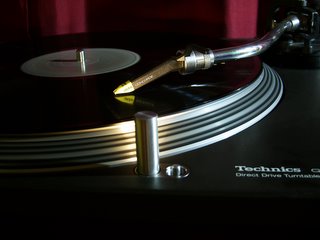
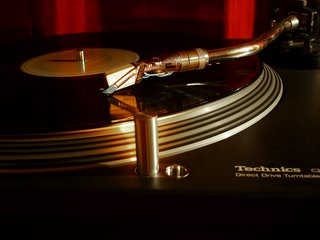
The tonality of a photograph can either be a warm tone or a cool tone. A warm tone imparts ambiance and warmth in a photograph while a cool tone produces an impression of coolness. In film photography, you can either use a warming filter or a cooling filter to get the desired effect. In digital photography, these effects can be achieved at no cost to the photographer. If you want to make your photograph to impart a warm tone, just set the White Balance of your camera to "Daylight" while a "Tungsten" setting will have a tendency to produce a cooling effect. Shown above is an example of a cool tone while the photo below it exemplifies a warm tone.
Photographed in the example is a Direct Drive Turntable fitted with different cartridges, Ortofon Concorde Night Club E (above) and Shure White Label (below). In a direct drive turntable, the motor is located directly under the spindle (center of the platter) and is connected directly to the platter.
Friday, December 23, 2005
Svetlana 6L6GCs

 Vacuum tubes never fades away unlike solid state amplifying devices where they become a fad now and a fade later. This is a fact, these 6L6s were introduced in the audio world some seventy (70) years ago and they still sell today with new production tubes coming from China and Russia. The 6L6 is a "beam" tetrode and was originally developed by RCA engineers and became an instant hit when radio manufacturers started using it in the output stages of some audio applications.
Vacuum tubes never fades away unlike solid state amplifying devices where they become a fad now and a fade later. This is a fact, these 6L6s were introduced in the audio world some seventy (70) years ago and they still sell today with new production tubes coming from China and Russia. The 6L6 is a "beam" tetrode and was originally developed by RCA engineers and became an instant hit when radio manufacturers started using it in the output stages of some audio applications. 
Sunday, December 18, 2005
Cambridge Audio 640P Phono Pre-amp

I recently got this phonostage to replace my QED DS-1 MM phono preamp and I would say that I'm happy to hear a big leap in the quality of sound reproduction of my LPs. Before I took it home from Audio Den, the local distributor of Cambridge Audio here, I compared it with Pro-Ject Phono Box MKII since they are in the same price range. And what's the result? the 640P is an amazingly superior solid state phonostage!!
Excited to hear it on my system, I immediately hooked it up and played some mint records to initially judge its performance. Spinning Holly Cole's "Don't Smoke in Bed" album, I was mesmerized upon hearing "I Can See Clearly" track of the album which I never heard with so much ambience and airiness in Holly Cole's captivating voice. It's like having a premium cart attached to a Technics Direct Drive turntable where details abound and soundstaging is at its finest. Since I dig Crystal Gale's vocal prowess, I tried and played some of her better albums and I got the same impression, the details are oozing with so much abundance. I used to listen to my LPs at the 12 o'clock volume dial in my M99plus integrated amp but with this high gain phono pre-amp, I'm now enjoying music at the 10 o'clock volume dial. The causal effect? it takes my listening pleasure to higher level because i can now hear a cleaner sound without much of a hum unlike with my previous phonostage. This may be attributable to its design configuration where the power supply is isolated from the main chassis, hence, unwanted noise and other interference were minimized. This design equates to a much cleaner and more conditioned sound with no annoyance from the AC power source.
Next test discs were my good old rock albums and it predictably brought out the results i was expecting. This time the instrumentation were dissected with clarity and i was elated to hear more high frequency extension and greater dynamics from the beat and thump of rock music. I can say that this phonostage gave me a warm and dynamic welcome to the world of pure analog supremacy. I can now hear extended high frequencies, more defined bass and superb spatial resoultion in stereophonic experience. Performance-wise, nothing beats this creature if compared to similar products at the same price range.... Pro-Ject Phono Box and NAD PP2, step aside coz there's a new champion!!!

Saturday, December 17, 2005
Technics SL-1210 MK2

 I have already photo graphed this same turntable before at the same angle but with different mood light and i keep coming back. you might now agree with me that the SL-1200s might be the most photo graphed turntable of all time. this venerable disk spinner was introduced in the market as early as 1972 and it's still kicking ass, not much with the audiophiles but with the vinyl lovers in general. perhaps, the only inherent shortcoming of this turntable is the fact that it was a direct drive spinner. for the hardcore audionuts, they would prefer the belt driven turntables because accordingly, these types would not have any micro vibrations that produces edgy sound character and they would be constantly spinning at a uniform or more refined and stable speed as compared to direct drives.
I have already photo graphed this same turntable before at the same angle but with different mood light and i keep coming back. you might now agree with me that the SL-1200s might be the most photo graphed turntable of all time. this venerable disk spinner was introduced in the market as early as 1972 and it's still kicking ass, not much with the audiophiles but with the vinyl lovers in general. perhaps, the only inherent shortcoming of this turntable is the fact that it was a direct drive spinner. for the hardcore audionuts, they would prefer the belt driven turntables because accordingly, these types would not have any micro vibrations that produces edgy sound character and they would be constantly spinning at a uniform or more refined and stable speed as compared to direct drives.what the heck!! so much ramblings on sound quality issues... for me, the SL-1200 is a very sturdy turntable. this is the turntable that i considered as the best buy when i went back into vinyls. not that i can't afford the new production belt drives but for me, i find them quite fragile and not worthy of any experimentation. on the other hand, the SL-1200, despite being a rugged device, is seen and reputed as a high quality analog playback device. The SL-1200 is a very quiet turntable but it can amplify ticks and pops as well depending on the quality of your phonostage. i've used quite a number of phono preamp loaned by friends and paired with this SL-1200 and so far, based on what i've listened to, i'm very much satisfied with what i have... the Cambridge Audio 640P phono preamp. the one thing i noticed though is that the SL-1200 lacks the air and space i've heard from such better rigs as the Rega P3s but over all, it's ease of operation and very engaging sound attributes are what makes it so close for comfort!

Wednesday, December 14, 2005
103.5 K-Lite FM

 On the FM band, 103.5 K-Lite, Manila's Lite Alternative, is my favorite FM station. They play a variety of musical genre, from rock to pop and mostly alternative rock. they also play some classic rock and new wave music on weekends. what I like most with this station is that they have plenty of contests where any listener can join and have a crack at winning CDs, movie tickets, concert tickets or anything under the sun.
On the FM band, 103.5 K-Lite, Manila's Lite Alternative, is my favorite FM station. They play a variety of musical genre, from rock to pop and mostly alternative rock. they also play some classic rock and new wave music on weekends. what I like most with this station is that they have plenty of contests where any listener can join and have a crack at winning CDs, movie tickets, concert tickets or anything under the sun.shown in the photos is a Cambridge Audio 640P Phono pre-amp sitting on top of a Pioneer F-403 tuner.

Saturday, December 10, 2005
Margarita sings at The Boulvar


 Dining can be a lot more fun if someone like Margarita sings in front of your table. Her engaging vocals suits her repertoire of music which includes a lot of interpretation of fine jazz classics. You can see her perform every Thursday night at The Boulvar Lobby Lounge of Manila Pavillon Hotel. Fun starts at 9:00 P.M. onwards.
Dining can be a lot more fun if someone like Margarita sings in front of your table. Her engaging vocals suits her repertoire of music which includes a lot of interpretation of fine jazz classics. You can see her perform every Thursday night at The Boulvar Lobby Lounge of Manila Pavillon Hotel. Fun starts at 9:00 P.M. onwards. 
Wednesday, December 07, 2005
Aurum Cantus F6600
Tuesday, December 06, 2005
Dali Ikon 2 vs Concept 6
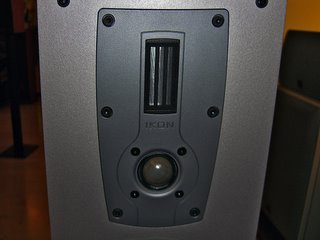
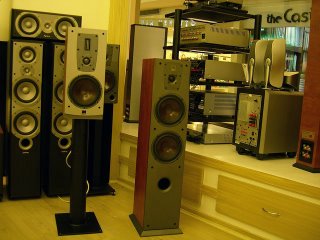
I had a chance to hear these two fabulous Dali speakers at the Architectural Audio in Greenbelt. The Ikon 2 is a bookshelf equipped with a hybrid tweeter module composed of a ribbon tweeter and a soft dome tweeter. The midbass driver is 6.5 inches delivering sonic reproduction capability at a frequency range of 42-30,000 hertz.
The Concept 6, on the other hand, is a 2 way bass reflex system with two 6.5 inches low frequency drivers and a 1 inch textile dome high frequency driver boxed in a floorstander capable of delivering a frequency response of 41-25,000 hertz. Nominal impedance of both speakers is at 8 ohms.
Verdict: the Ikon 2 is a lot more pleasant to hear with a broader stereo dispersion. Its attribute of being discrete in sound reproduction makes the speakers disappear in the soundstage while the listener enjoys unprecedented 3D-like audio experience with so much ambiance and airiness in music. Play some Jacintha songs and you'll immerse yourself in a total aural experience.

Sunday, December 04, 2005
Mariz

 it's a Saturday night, December 3, and the inebriation went on till the wee hours of the morning,
it's a Saturday night, December 3, and the inebriation went on till the wee hours of the morning, and a friend of mine was still able to flash a smile and remain energetic at past 6am of December 4. it's amazing how some people, at a youthful age, would have a very high threshold on stress and fatigue. i was dead tired, burn out and wasted the following day and spent most of the Sunday recuperating from a malaise brought about by a hang over. taken inside Street Life Acoustic Bar

Saturday, December 03, 2005
J3 and Nico

i went to Cebu a couple of weeks ago and visited some friends. shown in the photo are the two kids of my brod, J3 and Nico, 4 y.o. and 3 y.o. respectively. the close proximity in the ages between these two little brothers is giving their parents a difficult time tempering down sibling rivalry. they would always compare notes when they receive something by way of gifts. give them identical toys and after a day or two, they won't touch them again. give them different toys and they will start nagging their parents to buy another of a kind like the other one has.
moral of the story: when making kids, be sure to space their birth at least 3 years apart if you want to have them in the same sex. :)
while tinkering with this photo on the PhotoShop, i just discovered a new b&w conversion technique using the desaturate adjustment layer followed by the shadows/highlights adjustment layer. i used to appreciate the channel mixer technique but when i tried manipulating this photo using the channel mixer, i can't get the right mix inasmuch as the photo was fairly overexposed. however, using the shadows/highlights adjustment layer after desaturation, dropping down all the menus and options for adjustment like the radius pixel, tonal width etc., i was able to eliminate the flash glare on the face of Nico while at the same time maintaining a good contrast on the face of the two kids.

Sunday, November 27, 2005
into the groove

this cartridge, a Grado Green, was the first audiophle grade cart that i've listened to and appreciated. my Ortofon Concorde Night Club cart was designed for use as DJ cart and if compared to this cart, i would say that the Grado Green excels on music with predominantly vocals like that of Diana Krall, Patrcia Barber, Rebecca Pidgeon, Jacintha and the like. in short, i would choose this cart if playing jazz and soft music is the order of the day. on the other hand, DJ carts like the Ortofons would thrive on the club scene or when playing bouncy beats and bassy tunes is way up in your preference.

Tuesday, November 15, 2005
platter in strobelight
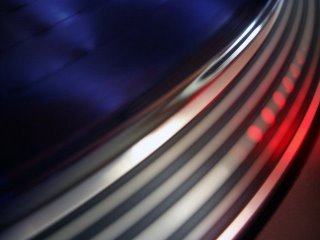
This is a close-up photo of the SL-1210 MK2's rotating platter. The red dots shown on the platter of the turntable is an indication that the rotation speed of the platter is in synched with the chosen RPM which is 33-1/3 RPM for a long playing album. If you will adjust the Pitch Control, the red dots will either appear streaming forward if the pitch control is pushed to a faster speed or will appear streaming backwards if pulled to a slower speed. The red dots will either shift upwards or downwards depending on the chosen RPM bias setting. A clever Japanese innovation which is not thought of by the Americans in their direct drive turntables. and that’s why the Technics SL-1200 MK2 and its later siblings were all-time favorites!

Monday, November 14, 2005
Tonearm Controls

Tuning the turntable is quite a time consuming task with so many rituals to perform. What is shown in the photo are the basic tonearm controls on my Technics SL-1210 MK2 turntable.
Adjustments made on the counterweight of the tonearm counterbalances the weight of the arm and the cartridge. The use of a tracking force gauge is indispensable here but you can blindly do away with it if you know your cartridge’s recommended weight which is now readily available thru the internet. This can be done by doing your calibration on the counterweight dial which should be properly set to defeat the tonearm’s anti-skate mechanism which is initially set at zero. If you do not have a tracking force gauge, but the arm does have a calibrated counterweight, defeat the arm’s anti-skate or set it to zero or whatever setting you have in your anti-skate mechanism control.
Another control that requires tweaking is the Vertical Tracking Angle (VTA) adjuster which calibrates the arm height. Altering the height means increasing or decreasing the tracking force on the vinyl grooves which may, of course, produce a different result not only in terms of sonics but also on the wear and tear of the vinyl record. More height means more pressure applied on the grooves by the touching stylus and vice versa. The more pressure on the weight applied by the stylus also produces a bigger sound and the lesser weight means shallow bass, muddy lows, dull sound or harsh midrange. Tune according to what you hear while playing and listening to your most familiar music. If the tracking force is too light, you’ll need to raise the VTA to achieve a deeper bass and more detailed presentation of your music but doing so will accelerate the wear and tear of your favorite vinyl record.
Adjusting the anti-skate mechanism opposes and balances the force of the natural inward drag of a pivoting arm while playing. If not corrected, the stylus will produce a so-called inner groove distortion which is what happens when the stylus would have the tendency to push up against the inner groove wall, thus, the distortion is the result of mistracking while the record is rotating or playing. The anti-skate force is properly set if the arm would no longer sway towards the spindle or the label of the record and if it would stand still while tracking the vinyl grooves when playing. The safest approach to this tuning process is to increase antiskate force until the arm starts to slowly drift outward or away from the record label.
Individual adjustments made on these three controls mentioned would produce a change in sound so an optimization usually depends on the ears of the listener.

Thursday, November 10, 2005
Deck Controls
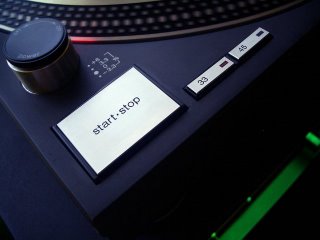
Some trivia for you guys who are not much into hi-fi audio....
The Technics SL-1200 MK2 was not originally intended as a DJ deck when it was first released in 1972. it became popular only as a DJ machine because of its versatility and rugged build which was highly appreciated during the advent and popularity of disco and hip hop music. This sturdy turntable has been around for more than 3 decades now and it has withstood design changes even with the latest MK5 which was last produced in 2002. This turntable is built like a tank because it weighs more than 26 lbs.
”Here’s where the Technics stands head-and-shoulders above, well, everything else. Virtually every control has a positive, very expensive feel (except the pitch slider, which feels a little ‘scratchy’ as it moves). Tap the ‘start’ button and in 0.7 seconds, the platter is up to speed. Tap it again and it stops just as quickly. Adjustable electronic braking can bring the platter to an even quicker halt if for some reason one second isn’t fast enough.
The platter weighs five pounds and is damped with hard rubber on the bottom. Whack it with a baseball bat and it still won’t ring. (The rubber record mat adds another 17 ounces.) Give the platter a spin with your hand, and it whirls like a greased roulette wheel. I wondered if it would ever stop spinning! It has great flywheel action, and judging by the smoothness of rotation, the bearing must be pretty well machined.” (quoted from an Audiogon Review of the SL-1200MK2)

Friday, November 04, 2005
SACD Player vs. CD Player
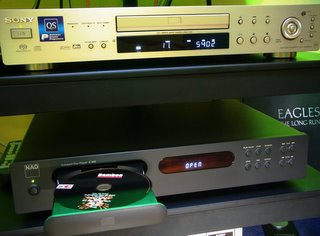 playing the same title in SACD and the redbook CD format, which would you choose?
playing the same title in SACD and the redbook CD format, which would you choose?With Rebecca Pidgeon's The Raven album (Chesky SACD & CD) as the test CDs, both the SACD and CD version were alternatively played for purposes of an A-B comparison of the two formats using Sony DVP-NS915V for the SACD and NAD C542 for the CD. The SACD Player was hooked to Consonance m99+ tube amp using Tara Labs Prism 5 interconnects while the CD Player was linked to the same amp using Ixos 1014 Gamma Audition II Interconnects. The 2 interconnects have the same or similar characteristics being copper-based ICs. The speaker is inconsequential but for the sake of mentioning - it is a pair of Mordaunt-Short 914 floorstander.
The result: The SACD is no good or to put it plainly, it did not exceeded my expectation that it would sound a lot better than a good CD. In fact there were even times when I can say that the CD copy has more bits of resolution than the SACD copy. So, if I were you guys, don't waste your funds trying to appreciate the over-hyped and misplaced superiority of an SACD.
But that's just me.... you might have a better SACD Player.
I had doubts on what I heard so I let my eyes compliment my logic. I opened up the hood of both players and visually compared what's inside and carefully located and identified the critical components like the power transformers, DACs, op-amps, and capacitors since these are the parts that play vital roles in the amplification process or in sound reproduction in general, and here's what I found out:
The CD Player is equipped with a toroidal transformer thrice the size of that of the DVD Player which is so disgustingly tiny and miniscule. Although the DVD Player may boast of having the Sony CDX2753 DSD chip to decode SACDs, the audio circuitry was designed in such a way that the front left and front right channel share only one op-amp, the rear left and the rear right channel also share only one op-amp as well as the center and the LFE out, totaling only three (3) op-amps for the 5.1 channel outputs. On the analog outs, there is another op-amp being shared by the right and left channel in stereo mode. These op-amps are fed to Elna capacitors of so miniscule in size and in value. Compared to the CD Player, it is gifted with Burr Brown PCM 1732 DAC with integrated HDCD Decoder and separate op-amps for the left and right channel with audiophile-grade Nichicon capacitors with values ranging from 1000uF to 6800uF. Looking at the connectors, the CD Player boast of having a pair of gold-plated RCA connectors compared to the tin-plated connectors of the DVD Player.
So, how in the world can these low end DVD Players (like the Sony SACD Player) beat the hell out of the CD Player's capability and potential to make better music even if you play SACDs on these DVD Players? I would have to agree that SACDs may sound a lot better if these are played on high end SACD Players which are prohibitively priced beyond my reach.
I am not an avid fan of multi-channel music for the simple reason that I can hardly appreciate music coming out from 6 different sources. What's so thrilling about listening to the two-channel medium is that it affords the listener the chance to localize the instruments being played through your system's capability to project imaging and visualize ambience through its soundstaging facility. I just can't equate multi-channel music from a real concert performance where the sound emanates only from the fronts unlike with multi-channel systems where sounds may come from different directions.
To each his own maybe?

Tuesday, November 01, 2005
NAD C542 CD Player
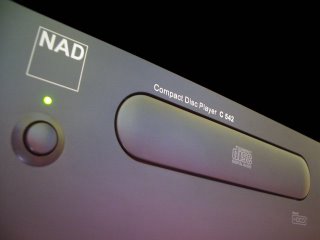
My first CD Player was a NAD C521i. Because I love this gear so much, I decided to let it go to let the newer C542 mystify my senses. Inasmuch as owning a NAD C542 is a big leap from my former entry-level CD Player, I immediately noticed remarkable improvements, both aesthetically and sonically. The C542 is a notch higher model than my previous C521i and equally smartly built based on NAD's signature of simplicity and superb technology.
Except for the HDCD decoder LED that I now see on the faceplate, the all-familiar battleship grey color on its casework is still immaculate although the newer model now sports a rounded or circular corners on the front plate. The inside mechanism of its moving parts audaciously stands out with remarkably silent operational feel. The C542's sonic character is one that exudes desirable qualities like superb fidelity letting you enjoy more dynamic range, precised imaging, focused soundstage and extremely natural vocal and musical timbre - being an HDCD equipped player. It is like akin to inserting a WS Tono Preamp between the source and the amp whereby the previously faint or unheard of reproduction suddenly becomes alive and readily discernible. As reviewed by its maker - the C542 is boasting in low frequency slam and extension with timbral accuracy and lucid harmonic structure of its predecessor, the C541i.

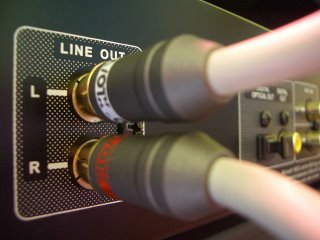
This is a player that I would like to settle with for keeps and enjoy over time or until an itch to upgrade to a higher model would, once again, become an incessant craving. I don't profess to be an expert in evaluating audio gears but certainly I wouldn't be contradicting my pair of ears when I say there is little much to be desired in its lucid and clean resolution. Compared to Rotel's RCD 1070 and Exposure's 2010, the best sounding CD Players that I've heard so far, this player doesn't quite rise to the heights of the better models I've mentioned above. Nonetheless, the C542 can recreate the full richness and detail of any recordings, though it may lack the expressive dynamic range of the 2010 and the punch and thump of the 1070. With proper coupling using better interconnects and cables, one can expect plenty of aural experience from the C542. By and large, the C542's overall signature can well be categorized as a good all-rounder CD Player with capability to play a wide variety of music types without slump in overall sonic quality.
As an example, Fleetwood Mac sounded so alive in "Dreams" while my favorite Style Council track "You're The Best Thing" is much like reminiscing the happier moments in life. Steely Dan's "Hey Nineteen" reminded me a lot of my good ole days while listening to "Pieces" by Patricia Barber is so involving. Diana Krall's "Look of Love" simply made me aware of her virtuosity as a pianist while at the same time letting me visualize how seductive she was in that music video of the same title. Playing my reference Chesky CD "The Ultimate Demonstration Disc", the C542's resolving prowess is an epitome of excellence in Rebecca Pidgeon's "Spanish Harlem". Some serious audiophile would say, the first upgrade we should mind to care is to make the most out of our source - based on the time-honored principle of "trash in - trash out". No matter how good our amp can be, aural fantasy simply begins and boils down to how proficient our source can decode, colorize and convey those signals to our amp's input.
Inasmuch as the C542 was christened by the ever reliable NAD, a Canadian firm advocating affordable but musically superior audio gears, this CD Player is warmly recommended.

Sunday, October 30, 2005
Ortofon Concorde Night Club E
 fitted with an Ortofon cartridge, the tonearm of the Technics SL-1210 MK2 glides seamlessly along the grooves of the vinyl. the Night Club series, tried and tested for its ruggedness, is not only a popular DJ needle but is likewise good for home audio analog applications. the Concorde mounts directly to the tonearm, thus, eliminating the need for a headshell or constant calibration.
fitted with an Ortofon cartridge, the tonearm of the Technics SL-1210 MK2 glides seamlessly along the grooves of the vinyl. the Night Club series, tried and tested for its ruggedness, is not only a popular DJ needle but is likewise good for home audio analog applications. the Concorde mounts directly to the tonearm, thus, eliminating the need for a headshell or constant calibration.this photo was desaturated using Photoshop Elements 2.0

vinyl is groovy
 The attraction to the rituals and beauty that vinyl LPs have is what keeps me spinning the black disks thru my Technics SL-1210 MK2 turntable rather than the convenience offered by playing CDs in my NAD C-542 CD Player, a respectably good CD Player with 24-bit DAC and HDCD Decoder.
The attraction to the rituals and beauty that vinyl LPs have is what keeps me spinning the black disks thru my Technics SL-1210 MK2 turntable rather than the convenience offered by playing CDs in my NAD C-542 CD Player, a respectably good CD Player with 24-bit DAC and HDCD Decoder. My obvious preference for the analog format is what keeps me photographing my old analog turntable and LPs, perhaps maybe because I’m sold out on the universal verdict and opinion that the finest sound quality currently available is from the analog microgroove record.

Saturday, October 29, 2005
Consonance M99plus Integrated Vacuum Tube Amplifier

I'm not an avid fan of tube equipped gears until I auditioned the Consonance M99plus integrated vacuum tube amp. Tube amps are misconceived as expensive pieces of equipment and are available only to a privileged and moneyed audiophiles. Inasmuch as this amp had been mass-produced in China, they are reasonably priced to afford tube newbies like me to explore and experience the wonderfully magical sound of tubes. Thus, owning this competitively priced tube amp, sporting the Consonance brand, adds pride of ownership and brings tube quality sound within the budget of almost every music lover.
My preference and growing interest on tube audio was the result of my conclusion that CD sound can never approximate the analog sound of the resurrected vinyls. Be that as it may, a tube amp can nonetheless, give life to the clinical and harsh sound of most CD players, which can often sound smoother and more musical when played through a tube amplifier. This premise goes without saying that tube amps are the better amps if compared to solid state amps but since my musical preference is now leaning towards the quieter genre and more relaxing music, it necessarily follows that I have to follow the route that would put me closer to the music. Gone are the days when I crave for the slam-bang and kick-ass bass of a solid state amp. Now, my aural experience begins when I listen to the more soothing sound of tubes that occasionally brings shivers to the bone and spine-tingling sensation when playing some of my favorite CD tracks.
The m99plus features 4 Shuguang 6P3P output tubes (which can be replaced by 6L6s, KT-66s and 5881s), 2 Shuguang 6N8P driver tubes (which can be replaced by 6SN7s and VT-231s), 2 Electro-Harmonix 12AX7EH pre-amp tubes configured in a SRPP circuitry, 3 toroidal transformers, 3 gold plated line inputs, large high quality gold plated 5-way speaker binding posts in 8 ohms and 4 ohms tap, all housed in a massive metal chassis with wooded side panels, weighing almost 18 Kgs. The m99plus is a solid-state rectified amp and equipped with a solidly-built remote control allowing you to adjust the volume from a distance.

M99plus on mood light
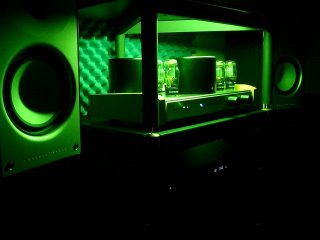 shown on top of the rack is the fifth anniversary model, with volume and input selector. Due to reasonable input sensitivity, can be connected direct to CD source. If connected using a separate pre-amplifier the sonic result will be even better. The circuit composes of three stages: Sovtek 12AX7LPS (ECC83) as the first SRPP stage, followed by Shuguang 6N8P (6SN7) driver stage with Shuguang 6P3P (6L6GC/KT66/5881) as the final power stage in class push pull class AB configuration. This is a classical circuit and the sonic performance is very high due to the design of the output transformer, tube circuit optimization and years of experience in the development of the M100SE. Uses fixed bias design with external individual bias adjustment for each 6P3P.
shown on top of the rack is the fifth anniversary model, with volume and input selector. Due to reasonable input sensitivity, can be connected direct to CD source. If connected using a separate pre-amplifier the sonic result will be even better. The circuit composes of three stages: Sovtek 12AX7LPS (ECC83) as the first SRPP stage, followed by Shuguang 6N8P (6SN7) driver stage with Shuguang 6P3P (6L6GC/KT66/5881) as the final power stage in class push pull class AB configuration. This is a classical circuit and the sonic performance is very high due to the design of the output transformer, tube circuit optimization and years of experience in the development of the M100SE. Uses fixed bias design with external individual bias adjustment for each 6P3P.Control Functions: Volume, Select, Power On/Off
Inputs: CD, Aux and Line in
Specifications:
OUTPUT IMPEDANCE: 4,8 ohms. (User selectable)
Output Power at 1 kHz for less than 1%THD: 25W x2
Bandwidth at - 3dB: 6Hz to 60kHz
Input Sensitivity for Rated Output: 180mV
Signal / noise: 90dB
Input interfaces: 3 groups (RCA)
Input Impedance: 50k
Consumption: 90W
Tubes: 6P3Px4, 6SN7x2, 12AX7x2
Dimension: 446 (L) x 264 (W) x 155(H) mm
Weigh: 17kg(Net); 21kg(Shipping)

Subscribe to:
Posts (Atom)

